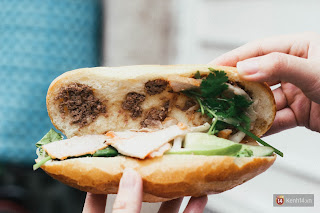Famous Vietnamese Poem
Xuân Quỳnh (6 October 1942 – 29 August 1988) is Vietnam's most famous modern female poet with many beautiful love poems such as Thuyen va Bien, Song, Tho tinh cuoi mua thu. Xuan Quynh’s poems were emotional with different sentiment levels, which resembled her characteristic.Her poems expressed happiness, passion, and sadness and were always close to readers because they were written from the fervidness of a woman who was a poet, a wife, and a mother. Unfortunately, she and her husband Lưu Quang Vũ and their 12-year-old son Lưu Quỳnh Thơ died in a car accident in Hải Dương city on 29 August 1988.
"Sóng" - Xuan Quynh
"Dữ dội và dịu êm
ồn ào và lặng lẽ
Sóng không hiểu nổi mình
Sóng tìm ra tận bể
ồn ào và lặng lẽ
Sóng không hiểu nổi mình
Sóng tìm ra tận bể
Ôi con sóng ngày xưa
Và ngày sau vẫn thế
Nỗi khát vọng tình yêu
Bồi hồi trong ngực trẻ
Và ngày sau vẫn thế
Nỗi khát vọng tình yêu
Bồi hồi trong ngực trẻ
Trước muôn trùng sóng bể
Em nghĩ về anh, em
Em nghĩ về biển lớn
Từ nơi nào sóng lên?
Sóng bắt đầu từ gió
Gió bắt đầu từ đâu?
Em cũng không biết nữa
Khi nào ta yêu nhau
Con sóng trên mặt nước
Ôi con sóng nhớ bờ
Ngày đêm không ngủ được
Lòng em nhớ đến anh
Cả trong mơ còn thức
Dẫu xuôi về phương Bắc
Dẫu ngược về phương Nam
Nơi nào em cũng nghĩ
Hướng về anh - một phương
Dẫu ngược về phương Nam
Nơi nào em cũng nghĩ
Hướng về anh - một phương
Ở ngoài kia đại dương
Trăm nghìn con sóng đó
Con nào chẳng tới bờ
Dù muôn vời cách trở
Trăm nghìn con sóng đó
Con nào chẳng tới bờ
Dù muôn vời cách trở
Cuộc đời đi dài thế
Năm tháng vãn đi qua
Như biển kia dẫu rộng
Mây vẫn bay về xa
Mây vẫn bay về xa
Làm sao được tan ra
Thành trăm con sóng nhỏ
Giữa biển lớn tình yêu
Ðể ngàn năm còn vỗ."
Thành trăm con sóng nhỏ
Giữa biển lớn tình yêu
Ðể ngàn năm còn vỗ."
English version
"Wave" - Xuan Quynh
"Fierce and gentle,
Loud and silent,
The river doesn't understand itself.The wave doesn't find itself until it reaches the sea.
Oh, the wave passes,
And the waves to come will be the same.
Hunger for love
Is strong in the heart.
And the waves to come will be the same.
Hunger for love
Is strong in the heart.
Standing before the waves,
I think of you and me.
I think of the great sea
And I wonder where the waves come from.
I think of you and me.
I think of the great sea
And I wonder where the waves come from.
The waves must come from the wind.
And I wonder where the wind comes from,
And I wonder
When will we love each other again?
And I wonder where the wind comes from,
And I wonder
When will we love each other again?
The waves deep in the sea
And the waves on the sea's surface
Long for the shore of the sea.
Day and night the waves cannot sleep
As I cannot sleep, even in dreams,
Because of my longing for you.
And the waves on the sea's surface
Long for the shore of the sea.
Day and night the waves cannot sleep
As I cannot sleep, even in dreams,
Because of my longing for you.
When I go to the North,
Or to the South,
When I go anywhere, I think of you,
My only direction.
Or to the South,
When I go anywhere, I think of you,
My only direction.
Out in the great sea
Thousands of waves are pushing,
Which one never reaches the shore
Even miles and miles from home?
Thousands of waves are pushing,
Which one never reaches the shore
Even miles and miles from home?
Life is so long;
Years and months go by.
Like the sea, life is endless.
Clouds fly to the distant horizon.
Years and months go by.
Like the sea, life is endless.
Clouds fly to the distant horizon.
How can I become
Like the hundreds of thousands of small waves
In the great sea of love
Like the hundreds of thousands of small waves
In the great sea of love
And lap forever against your shore?"



























































